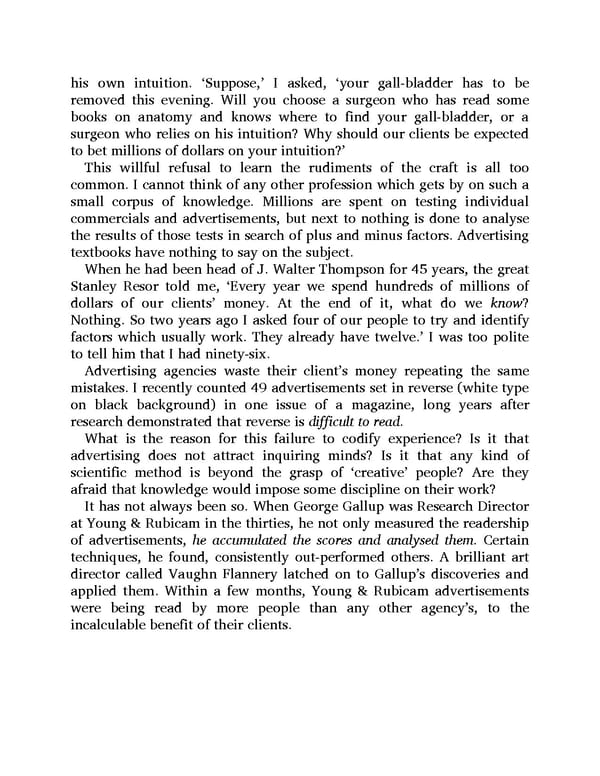his own intuition. ‘Suppose,’ I asked, ‘your gall-bladder has to be removed this evening. Will you choose a surgeon who has read some books on anatomy and knows where to find your gall-bladder, or a surgeon who relies on his intuition? Why should our clients be expected to bet millions of dollars on your intuition?’ This willful refusal to learn the rudiments of the craft is all too common. I cannot think of any other profession which gets by on such a small corpus of knowledge. Millions are spent on testing individual commercials and advertisements, but next to nothing is done to analyse the results of those tests in search of plus and minus factors. Advertising textbooks have nothing to say on the subject. When he had been head of J. Walter Thompson for 45 years, the great Stanley Resor told me, ‘Every year we spend hundreds of millions of dollars of our clients’ money. At the end of it, what do we know? Nothing. So two years ago I asked four of our people to try and identify factors which usually work. They already have twelve.’ I was too polite to tell him that I had ninety-six. Advertising agencies waste their client’s money repeating the same mistakes. I recently counted 49 advertisements set in reverse (white type on black background) in one issue of a magazine, long years after research demonstrated that reverse is difficult to read. What is the reason for this failure to codify experience? Is it that advertising does not attract inquiring minds? Is it that any kind of scientific method is beyond the grasp of ‘creative’ people? Are they afraid that knowledge would impose some discipline on their work? It has not always been so. When George Gallup was Research Director at Young & Rubicam in the thirties, he not only measured the readership of advertisements, he accumulated the scores and analysed them. Certain techniques, he found, consistently out-performed others. A brilliant art director called Vaughn Flannery latched on to Gallup’s discoveries and applied them. Within a few months, Young & Rubicam advertisements were being read by more people than any other agency’s, to the incalculable benefit of their clients.
 Ogilvy on Advertising Page 28 Page 30
Ogilvy on Advertising Page 28 Page 30